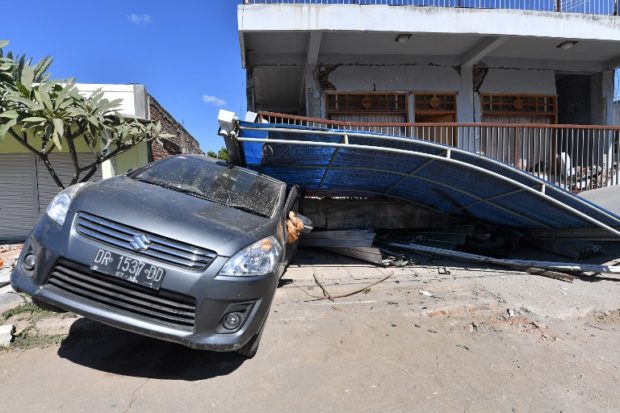
A damaged car and house are seen in Bangsal on August 7, 2018, after an earthquake struck the Indonesian holiday island of Lombok on Sunday. Terrified holidaymakers rushed for boats and planes to leave Indonesia’s Lombok island on August 7 after it suffered a second deadly quake within a week, while rescuers tried to reach hardest-hit areas where survivors are in urgent need of food and shelter. AFP
JAKARTA — A 7.0-magnitude earthquake rocked the island of Lombok, West Nusa Tenggara (NTB) on Sunday, just a week after a 6.4-magnitude quake hit the same area.
It also followed two quakes that occurred earlier on Sunday, a 5.6-magnitude one on the Mentawai Islands, West Sumatra, and a 5.2 one on the island of Flores, East Nusa Tenggara (NTT).
The quake
According to the Meteorology, Climatology and Geophysics Agency (BMKG), the earthquake was felt at 7:46 p.m. local time with an epicenter located 18 kilometers southwest of East Lombok with a depth of 15 km.
The agency initially placed the northern part of East and West Lombok on a tsunami alert soon after the quake but the alert was revoked at around 9:30 p.m. local time.
“Tsunami waves did hit the coast, but only at a height of 9 to 13 centimeters. The waves didn’t cause damage or casualties,” National Disaster Mitigation Agency (BNPB) spokesman Sutopo Purwo Nugroho said in a statement on Sunday.
The tremor was felt in neighboring Bali and some parts of East Java.
The aftermath
At the time of writing, the BNPB has recorded at least 91 people dead and 209 injured as a result of the quake. Thousands of buildings were damaged and thousands of people fled their homes after the tsunami alert.
The worst hit area was North Lombok regency, where at least 72 people were killed and 64 were injured. Sutopo said most of the deaths were caused by falling building debris.
Power outages also hit North and East Lombok, while Lombok International Airport sustained some minor damage and halted operations temporarily before resuming at 8:30 p.m. local time on Sunday.
Several buildings in Bali were also damaged by the quake, including the Denpasar Cathedral and Ngurah Rai International Airport, but airport operations continued as normal.
The initial earthquake was followed by over 132 aftershocks, and many residents remain unwilling to return to their homes for fear of another tremor.
Below is what we know so far about the earthquake.
The cause
Indonesia, which sits on the so-called “Ring of Fire”, is one of the most disaster-prone countries in the world.
Lombok is located in between two earthquake “generators”, namely the Flores back arc thrust to the north and the boundary of the Sunda and Indo-Australian tectonic plates to the south.
The BMKG said this quake and the 6.4-magnitude one last week were caused by upward movement of the Flores back arc thrust fault.
The thrust fault was formed due to friction with the Indo-Australian plate and was mapped in a 1981 joint expedition between the University of California Santa Cruz and the Indonesian Institute of Sciences (LIPI).
The Volcanology and Geological Hazard Mitigation Center (PVMBG) at the Energy and Mineral Resources Ministry said the area of the epicenter of the quake consisted mostly of volcanic sediment that had been raised up and weather-beaten.
The weathered nature of the sediment can strengthen the effects of a vibration, which makes the area susceptible to earthquakes.
The response
The BNPB said it was working together with the Indonesian Military (TNI), the National Police, the National Search and Rescue Agency (Basarnas) and several ministries and non-governmental organizations for its emergency response.
“The focus is currently on searching for, rescuing and aiding residents that were affected by the earthquake and fulfilling their basic needs,” Sutopo said in a press conference on Monday.
The TNI sent three planes to Lombok carrying medicine, logistics, tents, communication devices and food on Monday morning, while state-owned electricity company PLN said in a statement it was working to restore power to East and North Lombok.
Foreign and domestic tourists on three small islands in North Lombok – Gili Trawangan, Gili Air and Gili Meno – have also been evacuated by Basarnas.
An estimated 1,000 tourists were vacationing on the islands and are set to be transported the main Lombok island.